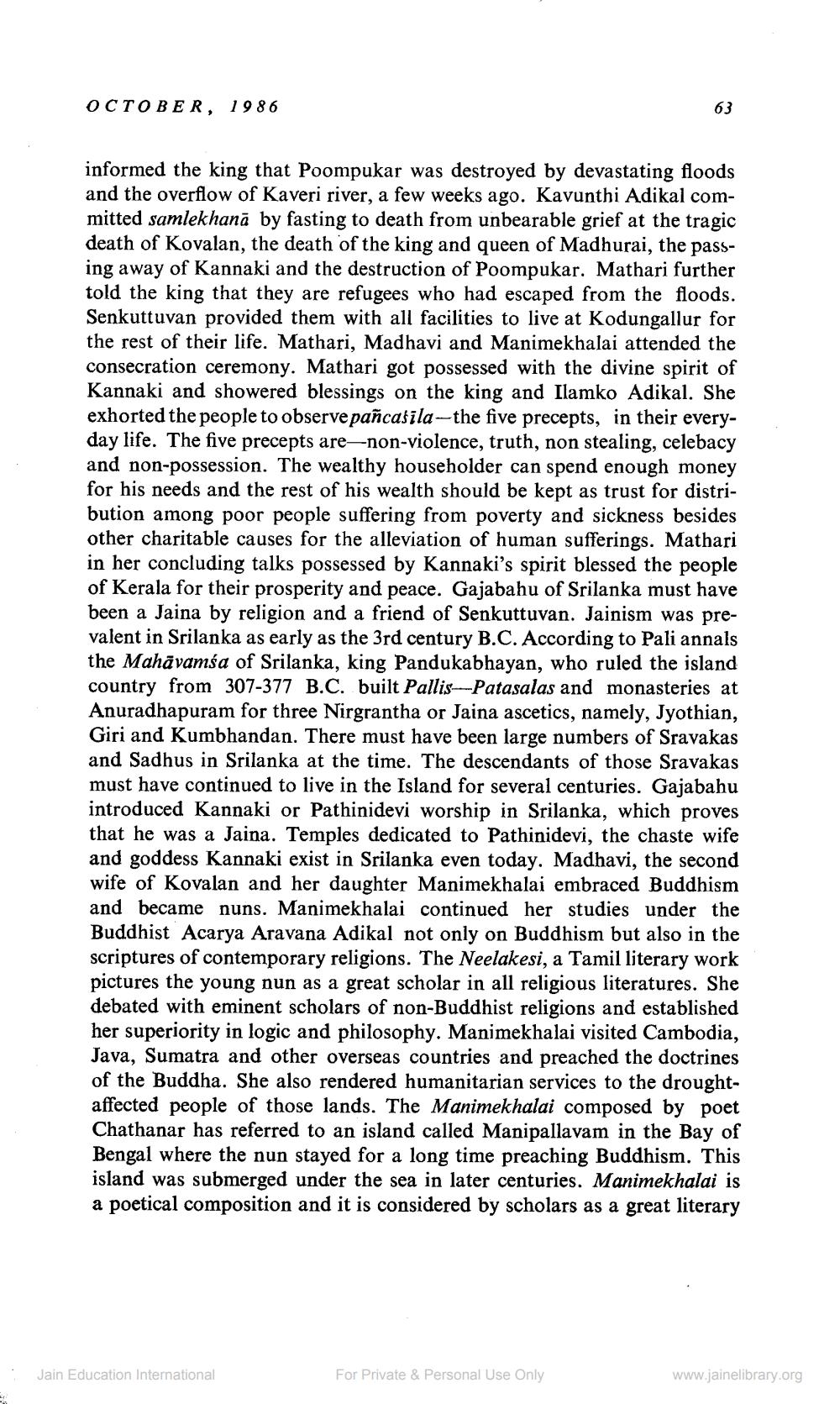________________
OCTOBER, 1986
informed the king that Poompukar was destroyed by devastating floods and the overflow of Kaveri river, a few weeks ago. Kavunthi Adikal committed samlekhana by fasting to death from unbearable grief at the tragic death of Kovalan, the death of the king and queen of Madhurai, the passing away of Kannaki and the destruction of Poompukar. Mathari further told the king that they are refugees who had escaped from the floods. Senkuttuvan provided them with all facilities to live at Kodungallur for the rest of their life. Mathari, Madhavi and Manimekhalai attended the consecration ceremony. Mathari got possessed with the divine spirit of Kannaki and showered blessings on the king and Ilamko Adikal. She exhorted the people to observe pancasila-the five precepts, in their everyday life. The five precepts are-non-violence, truth, non stealing, celebacy and non-possession. The wealthy householder can spend enough money for his needs and the rest of his wealth should be kept as trust for distribution among poor people suffering from poverty and sickness besides other charitable causes for the alleviation of human sufferings. Mathari in her concluding talks possessed by Kannaki's spirit blessed the people of Kerala for their prosperity and peace. Gajabahu of Srilanka must have been a Jaina by religion and a friend of Senkuttuvan. Jainism was prevalent in Srilanka as early as the 3rd century B.C. According to Pali annals the Mahāvamsa of Srilanka, king Pandukabhayan, who ruled the island country from 307-377 B.C. built Pallis-Patasalas and monasteries at Anuradhapuram for three Nirgrantha or Jaina ascetics, namely, Jyothian, Giri and Kumbhandan. There must have been large numbers of Sravakas and Sadhus in Srilanka at the time. The descendants of those Sravakas must have continued to live in the Island for several centuries. Gajabahu introduced Kannaki or Pathinidevi worship in Srilanka, which proves that he was a Jaina. Temples dedicated to Pathinidevi, the chaste wife and goddess Kannaki exist in Srilanka even today. Madhavi, the second wife of Kovalan and her daughter Manimekhalai embraced Buddhism and became nuns. Manimekhalai continued her studies under the Buddhist Acarya Aravana Adikal not only on Buddhism but also in the scriptures of contemporary religions. The Neelakesi, a Tamil literary work pictures the young nun as a great scholar in all religious literatures. She debated with eminent scholars of non-Buddhist religions and established her superiority in logic and philosophy. Manimekhalai visited Cambodia, Java, Sumatra and other overseas countries and preached the doctrines of the Buddha. She also rendered humanitarian services to the droughtaffected people of those lands. The Manimekhalai composed by poet Chathanar has referred to an island called Manipallavam in the Bay of Bengal where the nun stayed for a long time preaching Buddhism. This island was submerged under the sea in later centuries. Manimekhalai is a poetical composition and it is considered by scholars as a great literary
Jain Education International
63
For Private & Personal Use Only
www.jainelibrary.org




